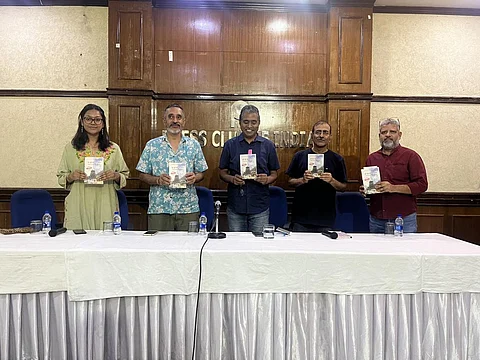

The nexus between politicians and builders has to be weakened if Uttarakhand and its people are to control their water, land and forests, experts said at a discussion on the occasion of the relaunch of a book first written a decade ago, during the Kedarnath floods in the state.
Journalist Hridayesh Joshi, who was with the New Delhi Television network’s Hindi channel at the time, had written Tum Chup Kyon Rahe Kedar (Why did you remain silent, Kedar) based on his experiences while reporting on one of post-Independent India’s worst environemental tragedies.
A cloudburst on June 16-17, 2013 led to massive floods and landslides in and around the Kedar Valley of Uttarakhand, home to the Kedarnath temple, sacred in Hinduism.
Joshi, veteran environmental journalist Nitin Sethi, Uttarakhand expert Alok Joshi and others relaunched the book at the Press Club of India on June 17, 2023.
“The book needed updation. I had incorporated a lot of updates and additions in these 10 years since the tragedy. I thought the decadal anniversary of the disaster would be an appropriate time to relaunch the book,” Joshi said.
During the course of the programme, Sethi, Joshi and journalist Jayashree Nandi Achom held a discussion on the state-of-affairs in Uttarkhand in the 10 years since the Kedarnath floods.
Sethi was of the view that the carving out of Uttarakhand from a united Uttar Pradesh in 2000 had not served the objectives for which the movement towards state formation had been launched.
“The formation of Uttarakhand has not served the objectives of the movement. Water, land and forests in all these three states (Uttarakhand, Jharkhand and Chhattisgarh) still are not under the control of the people, especially indigenous inhabitants. If anything, the corruption that was in place in Lucknow, has been decentralised to Dehradun, Nainital and Haldwani,” he noted.
Sethi blamed the politico-builder nexus for the troubles faced by the state.
“Everyone knows development in the hills will have to be different from the plains. But the politics remains the same. Till the time the politico-builder nexus in Uttarakhand is not broken, the status quo will remain in place,” he added.
Indeed, in the years since Kedarnath, Uttarakhand has witnessed other environmental tragedies such as the 2021 glacial outburst flood of the Rishiganga river near the historic Raini village, the birthplace of the Chipko movement.
This year also saw the massive land subsidence in the town of Joshimath in Uttarakhand. In both cases, experts in Himalayan ecology attributed intensive construction for civic works being carried out in the fragile Himalayan landscape as the primary reason.
“We have not learnt anything from Kedarnath, Rishiganga and Joshimath. The latter only made national news when it started to cave in completely. Before that, it was just business-as-usual. As for Kedarnath, there has been more intensive construction since 2014. All in the name of development,” he added.
Sethi pointed out that it was not that the people of the Indian Himalayas did not need civic works to provide amenities. They need roads, hospitals and schools. But it is not at all difficult to find out how much is needed, he noted.
Joshi also narrated how he came to write the book. He came upon a woman wailing the loss of her sons who died in the disaster even though her grandchildren were spared.
“The magnitude of this tragedy was incomprehensible at the time. Happening as it did at such a height, followed by a massive rescue operation, the deaths of relief personnel, people trudging down at such great distances...it moved the whole country,” he said.
Asked if seeing deaths at such close quarters left him disturbed, Joshi said it was part of the job. “Reporters see death daily. Just before Kedarnath happened, I was in Bastar, Chhattisgarh, where 30 people had been killed by Maoists. You feel bad for sometime. But then you go back to reporting again,” he said.